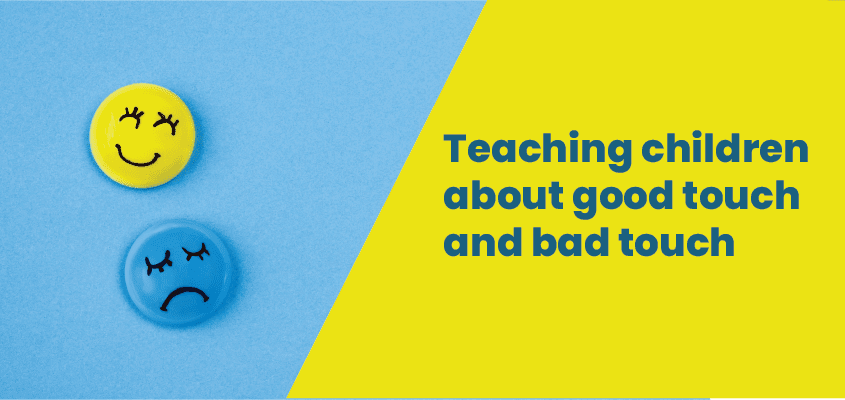Introduction
Parents should prepare their children for any unwanted situation in today’s increasingly corrupt world [1]. Every parent wants to keep their child safe, and they must teach them to deal with every situation in life. Children should know what to do during physical abuse and how to handle the case. Hence, ensuring your child learns about good and bad touch is essential to keep them safe and prepare them for unpleasant situations.
What is a good touch and bad touch?
- Safe touch: Safe touch protects and makes children secure and comfortable. Hugging, an arm on the shoulder, and pats can be considered safe touches. Removing harmful objects from the skin is also safe to touch, done to protect the child.
- Unsafe touch involves touches that harm the child and can hurt their feelings. Hitting, pushing, and kicking can be considered hazardous, and you should tell your child these types of touches are unsuitable.
- Unwanted touch: This can be safe, but children may not feel comfortable with the person or situation. Tell them to say ‘no’ or ask them to stay away if they feel uncomfortable. Make your child practice saying ‘no’ firmly but respectfully. You should also maintain a friendly relationship with your child so they feel comfortable and safe sharing everything with you.
How can parents teach their children about good touch and bad touch
- Make the child aware of their body: Tell them nobody can touch their body badly. Make your child confident to speak up against their friends or siblings if they push or hit them. Gradually teach them about their body parts and tell them that nobody has the right to see or touch their private body parts.
- Swimsuit method: If the child is young, you can use it to make them aware of their private body parts. Tell them that the body parts covered by the swimsuit are personal, should remain hidden in public and that nobody can touch them.
- Do not force touch: If your child feels unsafe hugging relatives or family members, do not force them to. Let your child use verbal greetings and make them feel comfortable setting boundaries.
- Use books: If you feel uncomfortable initiating the conversation, many good books are good guides for children. These books use simple examples to educate the child on good and bad touch.
- Friendly communication: Make your child feel comfortable and maintain a close relationship with them. They should not feel ashamed to talk to you about any situation. Make them feel understood. Please do not laugh at them. The child should never feel afraid while reporting any relative or friend to you. Tell the child that you will always be there to support them [2].
- Roleplaying: Prepare a small skit/play based on good and bad touches to help them understand better. Roleplaying is an excellent way of teaching your child how to handle the situation if someone touches them inappropriately.
Why is it important to teach children about good touch and bad touch?
A child should be able to distinguish between a good and bad touch. Every child should be able to react accurately and get the confidence to inform elders. A child should not harbour negative feelings about anyone yet be assured not to carry the guilt of a bad touch. In such scenarios, a child can nest negative emotions of a bad touch forever, which may cause emotional disturbances later in life.
What are some signs of good touch and bad touch?
[4] Sound touch is when the parents or relatives show affection to protect the child. It does not make the child uncomfortable, and feels safe in that person’s company.
The signs of lousy touch are:
- The child cries when you leave them with a specific person.
- The child starts behaving rudely after seeing a particular person.
- The child’s clothes need to be included, with no reasonable explanations.
- The child has red patches or marks on their body. They may feel irritated all the time.
- The child suddenly clings to you, expresses fear of someone, or wants to co-sleep.
- The child suddenly develops a negative attitude.
What should parents do if they suspect their child has been touched inappropriately?
- Keep a watch on babysitters and educators: Keep a regular check on babysitters and conduct surprise visits to assess the child’s safety. Many governments also allow guardians to do a background check when hiring a babysitter so that they can choose the right caregiver for their child.
- Make yourself approachable: You should give proper time and care to your child. You should maintain a friendly relationship with your children, so they do not hesitate to share anything with you. Make them feel understood and heard, and make yourself available for your child’s help.
Resources for parents and children on good touch and bad touch
Teaching your child about good touch and bad touch is essential. If you cannot communicate the message to your child, contact the online mental health portal [3] United We Care. Our pool of experts can help you guide your children to mental health. Download our app, Stella, or contact us to open the doorway to well-being.
References:
- P. MANISHA, “AWARENESS OF GOOD AND BAD TOUCH AMONG CHILDREN,” i-manager’s Journal on Nursing, vol. 8, no. 2, p. 1, 2018, doi: https://doi.org/10.26634/jnur.8.2.14497.
- E. L. Ardiel and C. H. Rankin, “The importance of touch in development,” Paediatrics & Child Health, vol. 15, no. 3, pp. 153–156, Mar. 2010, doi: https://doi.org/10.1093/pch/15.3.153.
- “Result Professional,” United We Care | A Super App for Mental Wellness. (accessed Mar. 02, 2023).
- D. Narvaez et al., “The importance of early life touch for psychosocial and moral development,” Psicologia: Reflexão e Crítica, vol. 32, no. 1, Aug. 2019, doi: https://doi.org/10.1186/s41155-019-0129-0.
- “Contact Us,” United We Care | A Super App for Mental Wellness. https://www.unitedwecare.com/contact/ (accessed Mar. 02, 2023).











